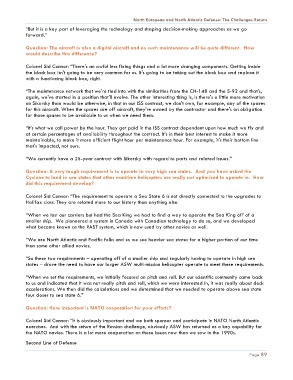Page 90 - North Atlantic and Nordic Defense
P. 90
North European and North Atlantic Defense: The Challenges Return
“But it is a key part of leveraging the technology and shaping decision-making approaches as we go
forward.”
Question: The aircraft is also a digital aircraft and as such maintenance will be quite different. How
would describe this difference?
Colonel Sid Connor: “There's an awful less fixing things and a lot more changing components. Getting inside
the black box isn't going to be very common for us. It's going to be taking out the black box and replace it
with a functioning black box, right.
“The maintenance network that we're tied into with the similarities from the CH-148 and the S-92 and that's,
again, we've started in a position that'll evolve. The other interesting thing is, is there's a little more motivation
on Sikorsky than would be otherwise, in that in our ISS contract, we don't own, for example, any of the spares
for this aircraft. When the spares are off aircraft, they're owned by the contractor and there's an obligation
for those spares to be available to us when we need them.
“It's what we call power by the hour. They get paid in the ISS contract dependent upon how much we fly and
at certain percentages of availability throughout the contract. It's in their best interest to make it more
maintainable, to make it more efficient flight hour per maintenance hour. For example, it's their bottom line
that's impacted, not ours.
“We currently have a 25-year contract with Sikorsky with regard to parts and related issues.”
Question: A very tough requirement is to operate in very high sea states. And you have asked the
Cyclone to land in sea states that other maritime helicopters are really not optimized to operate in. How
did this requirement develop?
Colonel Sid Connor: “The requirement to operate a Sea State 6 is not directly connected to the upgrades to
Halifax class. They are related more to our history than anything else.
“When we lost our carriers but had the Sea King we had to find a way to operate the Sea King off of a
smaller ship. We pioneered a system in Canada with Canadian technology to do so, and we developed
what became known as the RAST system, which is now used by other navies as well.
“We are North Atlantic and Pacific folks and so we see heavier sea states for a higher portion of our time
than some other allied navies.
“So these two requirements – operating off of a smaller ship and regularly having to operate in high sea
states – drove the need to have our larger ASW multi-mission helicopter operate to meet these requirements.
“When we set the requirements, we initially focused on pitch and roll. But our scientific community came back
to us and indicated that it was not really pitch and roll, which we were interested in, it was really about deck
accelerations. We then did the calculations and we determined that we needed to operate above sea state
four closer to sea state 6.”
Question: How important is NATO cooperation for your efforts?
Colonel Sid Connor: “It is obviously important and we both sponsor and participate in NATO North Atlantic
exercises. And with the return of the Russian challenge, obviously ASW has returned as a key capability for
the NATO navies. There is a lot more cooperation on these issues now than we saw in the 1990s.
Second Line of Defense
Page 89

